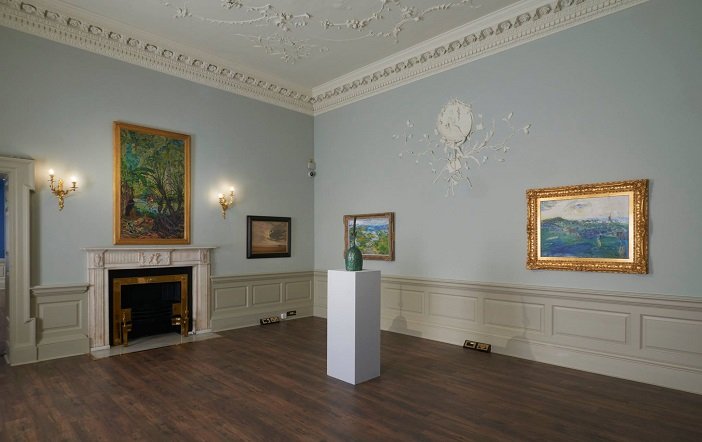Exhibition Review | Crawford at the Castle
From October 8th Dublin Castle has been hosting 59 art works from the Crawford Art Gallery, Cork. Spread across the State Apartments and the Coach House of the castle, this is the first time the Crawford has exhibited this extent of works in the nation’s capital.
Considering the historical nature of the site, it is interesting to observe how certain pieces, particularly in the State Apartments, engage directly with their setting. In addition to displaying the works chronologically, they are divided into different themes ranging from Enlightenment and Revolution to National Identity and document a turbulent Irish history over the centuries. The portraits of Dr. Emmet and Mrs. Emmet of the circle of Allan Ramsey (Ca. 1770) for example link the castle to the failed revolution of 1803 by Robert Emmet just outside the castle walls. Works tackling the Troubles, such as F. E. McWilliam‘s startling sculpture Woman in a Bomb Blast (1974) are placed in the Queen’s Bedroom, the very room in which Margaret Thatcher stayed during her official visit to Ireland in 1990. The majority of the pieces look more to the events of Irish history in general for inspiration, allowing multiple visual insights into the Irish famine and the war of independence, with works such as Muriel Brandt’s The Breadline, 1916 (1950) contrasting with masculine and militaristic Men of the South (1921) by Sean Keating.

As a celebration of Irish art over three centuries, big names from James Barry and Jack B. Yeats to Dorothy Cross are all great highlights, and truly show the wide range of pieces and the scope that that allowed the Crawford to be given the status of a National Cultural Institution in 2006. The breathtaking Red Rose (1923) by John Lavery is a work that captivates the attention of all who walk into the room. Despite his wife being the focus of four hundred other portraits, it is this work, with the rich and vibrant background contrasting to porcelain white skin and a haunting gaze of the sitter, which has become one of the most famous portrayals. The works relating to the theme ‘The Natural World’ include the venerated Jack B. Yeats and his nostalgic and introspective works which dominated the latter years of the artist’s career. The joyful colours of childhood memories and the sketchy impasto of After the Bathe, Mid Day (1948) and A Race at Hy Brazil (1937) create an intriguing puzzle for the viewer to piece together, extracting the movement and figures of the stories depicted.
The Coach House hosts contemporary lens-based media tied with the theme of power and control. Many of the art works here challenge the limits of perception, trust in ‘truthful’ photographic documentation and control over one’s own body. Three video works – Jelly Fish Lake (2002) by Dorothy Cross, Into the Mire (2011) by Nigel Rolfe and Last Man (2011) by Martin Healy – all display breathtaking visual imagery, challenging any remaining assumptions that film cannot reach the same aesthetic heights as traditional media such as paint. Cross’s Jelly Fish Lake is a particularly intriguing work which effects the human senses, challenging you not to flinch as stinging tentacles brush and weave across the female form, making you realise how closely linked your senses are to one another and question the extent to which we have control over our own bodies and our imaginations.
A slightly disappointing aspect of the exhibition display is the placement of almost all contemporary works in the coach house while the historical works remain solely in the state apartments. Practicality can be cited here as a reason – it’s easier to facilitate modern media in the more flexible space of the coach house – but bolder attempts to mix both historical works and contemporary media would have been welcome.That said, the Crawford is putting its best foot forward in this exhibition, proudly showing Dublin what Cork has to offer to not only the country but the world, and is on display until February 12th.

